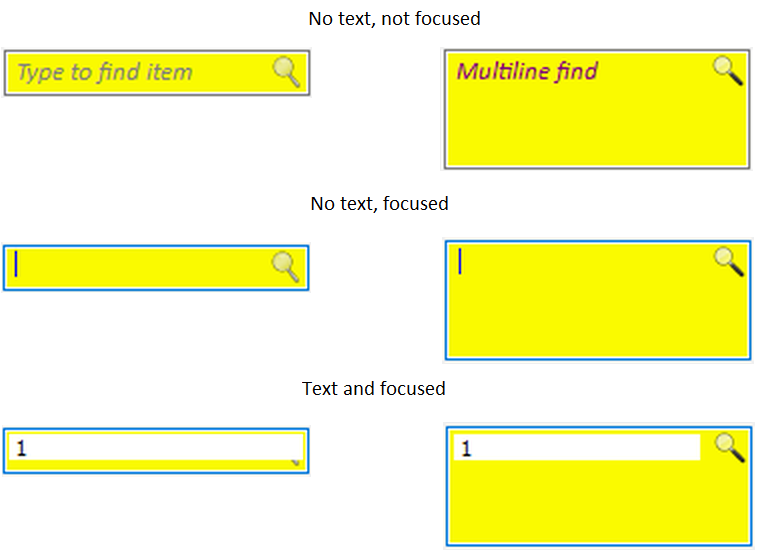I am trying to make a search edit control in MFC that has an icon displayed in the control window all the time (regardless the state and text of the control). I have written something like this many years ago and worked very well, but the code no longer works on Windows 7 and newer (maybe even Vista, but did not try that). What happens is that the image shown in the control is overlapped with the input area (see the picture below).
The idea behind the code:
- have a class derived from
CEdit(that handles painting in OnPaint) - the icon is displayed on the right and the edit area is shrunk based on the size of the icon
- resizing is done differently for single-line and multiline edits. For single line I call SetMargins and for multiline edits I call SetRect.
- this edit resizing is applied in
PreSubclassWindow(),OnSize()andOnSetFont()
This is how the edit input size is applied:
void CSymbolEdit::RecalcLayout()
{
int width = GetSystemMetrics( SM_CXSMICON );
if(m_hSymbolIcon)
{
if (GetStyle() & ES_MULTILINE)
{
CRect editRect;
GetRect(&editRect);
editRect.right -= (width + 6);
SetRect(&editRect);
}
else
{
DWORD dwMargins = GetMargins();
SetMargins(LOWORD(dwMargins), width + 6);
}
}
}
The following image shows the problem with the single line edits (the images have been zoomed in for a better view). The yellow background is for highlighting purposes only, in real code I am using the COLOR_WINDOW system color. You can see that when the single line edit has text and has the input the left side image is painted over. This does not happen with the multiline edit where SetRect correctly sets the formatting rectangle.
I have tried using ExcludeClipRect to remove the area of the edit where the image is being displayed.
CRect rc;
GetClientRect(rc);
CPaintDC dc(this);
ExcludeClipRect(dc.m_hDC, rc.right - width - 6, rc.top, rc.right, rc.bottom);
DWORD dwMargins = GetMargins();
SetMargins(LOWORD(dwMargins), width + 6);
This does not seem to have any effect on the result.
For reference, this is the painting method, written years ago and used to work well on Windows XP, but not correct any more.
void CSymbolEdit::OnPaint()
{
CPaintDC dc(this);
CRect rect;
GetClientRect( &rect );
// Clearing the background
dc.FillSolidRect( rect, GetSysColor(COLOR_WINDOW) );
DWORD dwMargins = GetMargins();
if( m_hSymbolIcon )
{
// Drawing the icon
int width = GetSystemMetrics( SM_CXSMICON );
int height = GetSystemMetrics( SM_CYSMICON );
::DrawIconEx(
dc.m_hDC,
rect.right - width - 1,
1,
m_hSymbolIcon,
width,
height,
0,
NULL,
DI_NORMAL);
rect.left += LOWORD(dwMargins) + 1;
rect.right -= (width + 7);
}
else
{
rect.left += (LOWORD(dwMargins) + 1);
rect.right -= (HIWORD(dwMargins) + 1);
}
CString text;
GetWindowText(text);
CFont* oldFont = NULL;
rect.top += 1;
if(text.GetLength() == 0)
{
if(this != GetFocus() && m_strPromptText.GetLength() > 0)
{
oldFont = dc.SelectObject(&m_fontPrompt);
COLORREF color = dc.GetTextColor();
dc.SetTextColor(m_colorPromptText);
dc.DrawText(m_strPromptText, rect, DT_LEFT|DT_SINGLELINE|DT_EDITCONTROL);
dc.SetTextColor(color);
dc.SelectObject(oldFont);
}
}
else
{
if(GetStyle() & ES_MULTILINE)
CEdit::OnPaint();
else
{
oldFont = dc.SelectObject(GetFont());
dc.DrawText(text, rect, DT_SINGLELINE | DT_INTERNAL | DT_EDITCONTROL);
dc.SelectObject(oldFont);
}
}
}
I have looked at other implementations of similar edit controls and they all have the same fault now.
Obviously, the question is how do I exclude the image area from the input area of the control?


OnPaintoverride is fighting against Edit control's paint routine. It usesCPaintDCto paint the control manually, sometimes it callsCEdit::OnPaint, which in turn callsCPaintDCagain, followed by default processing which repaints the client area. This will fail when Edit control goes in and out of focus, or when any paint message is received. – ConcertCEdit::OnPaint()is only called for multiline edits, which is not my concern. I am using only single line edit controls. I have mentioned multiline edits because in this case setting the bounds works correctly. – FidesCWnd::OnCtlColor()and callExcludeClipRect()from there? Seems to work fine here with a quick test, but without MFC. You might have to change clipping again in yourOnPaint()to show your own stuff. – Chelsae